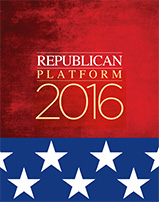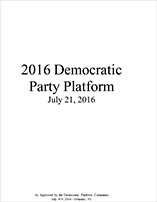With the advent of television and the widespread adoption of primaries, the national parties' nominating conventions have largely been reduced from decision-making bodies to a rubber stamp function. The conventions are, in fact, tightly scripted made-for-TV spectacles. Nonetheless, these quadrennial gatherings still fulfill a vital function in the life of the political parties and can provide a boost for the nominee.
Interest Groups ProtestsAtmosphericsEconomic Impact
Third PartiesRecent ConventionsResources
| Republicans |
Democrats |
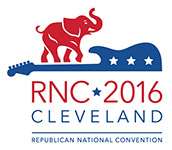 July 18-21, 2016 Quicken Loans Arena Cleveland |
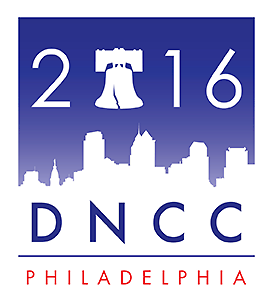 July 25-28, 2016 Wells Fargo Center Philadelphia |
The Changing Character of Conventions
In the past, the national convention served as a decision-making body, actually determining the party's nominee. For example, the 1924 Democratic National Convention in New York lasted 17 days and required 103 ballots to select John Davis as the nominee. The last Democratic Convention to go beyond one ballot occurred in 1952, when Adlai Stevenson won on the third ballot; the 1948 Republican Convention went to a third ballot before New York Governor Thomas E. Dewey won the nomination. Republicans had a close vote in 1976 in Kansas City when President Ford prevailed over Ronald Reagan by 1,187 votes to 1,070 votes.
Two significant changes
have
occurred in recent decades. First, most of the national
convention
delegates are now selected by voters in primary contests rather than by
party caucuses and meetings. Second, with the advent of
television,
conventions
have become tightly scripted made-for-TV spectacles. Each party
seeks
to present itself in the best possible light and to demonstrate a
united
front rather than to hash out its differences.
One could argue that
modern
day conventions are little more than four-day advertisements for the
political
parties. Because there is no longer much suspense, conventions
have
suffered declining viewership, coverage by the major networks has been
cut, and some observers have suggested that the conventions themselves
should be cut to three days.
For a while it appeared that 2016 might be different for the
Republicans. The unorthodox
candidacy of Donald Trump generated a significant number of
disaffected Republicans (#NeverTrump) and it appeared quite possible
that no candidate would achieve the 1,237 delegates needed to win the
party's nomination. In March and April 2016 there was a lot of
talk about the
prospect of a contested convention in Cleveland, but it ended rather quickly
following Trump's win in the May 3 Indiana primary and his assumption
of the mantle of presumptive nominee.
Even as rubber stamps, conventions still fulfill a vital function in the life of the political parties. In many ways, the essence of a convention is what happens off of the convention floor. In the lead-up to the convention, the drafting of the party platform provides interests aligned with the party a forum to present their concerns. During the days of the convention itself, hundreds of events, caucuses, receptions, breakfasts, fundraisers, and parties take place in the hotels surrounding the convention hall. At the end of the convention, party activists return to their communities energized for the fall campaign and, if all goes well, the presidential ticket emerges with a "convention bounce."
Both parties conducted lengthy site selection processes to determine which cities will host their conventions. Republicans started out with bids from eight cities, finally settling on Cleveland, OH. Democrats started with five possibilities, and opted for Philadelphia, PA.
While Republicans' three most recent conventions have
been held in late August and early September, RNC chairman Reince
Priebus made clear throughout the process his intention of holding the
2016 convention earlier, even suggesting the possibility of late
June. On Jan. 14, 2015 he announced the convention will be held
July 18-21, 2016 (+).
On
Jan. 23, 2015 DNC chairman Debbie Wasserman Schultz announced the
Democrats' convention will be held the week of July 25, 2016.
Both conventions will thus occur before the Olympic Games,
which will be held in Rio de Janiero from Aug. 5-21, 2016.
Once the host cities has been selected, the respective
convention
committees start work on the details of how to meet housing,
transportation, security needs of more than 40,000 people.
Republicans have a Committee on
Arrangements and
Democrats have a
Democratic
National
Convention
Committee.
Through 2012 the major party
conventions had been funded in part by grants from the Presidential
Election Campaign
Fund (the
$3 income tax check-off). The grants, set out in
the Federal Election
Campaign
Act, started at $2.2 million back in 1976 and were increased a couple
of times in addition to being adjusted for cost-of-living
increases. To prepare their 2012
conventions,
the Democrats and Republicans each received grants of about $17.7
million from the Treasury.
Starting in 2016, as a result of H.R. 2019: Gabriella Miller Kids First Research Act, signed into law on April 3, 2014, the national party committees will no longer receive federal grants to help them put on their conventions. That left the question of how to make up for the lost funding. On Oct. 9, 2014 the FEC, responding to an Advisory Opinion Request (AOR) filed jointly by the DNC and RNC, ruled that the national party committees can establish convention committees that can raise federal funds under separate limits. The decision was met with disfavor by campaign finance watchdog groups (+).
As important as the
party convention committees are host committees. [11
CFR
9008.52]. These non-partisan, non-profit 501(c)(3) committees
fulfill a
range of functions. Early on
they promote the city's bid. If
the city is successful, the host committee sets to work raising money
and
in-kind contributions, recruiting volunteers and organizing events and
activities to welcome delegates and media. Corporate
contributions
to host committees and "municipal funds" have comprised an increasing
share
of spending on conventions, leading for some to call for stricter
regulations. The Campaign Finance Institute has argued that
"policies
of the Internal Revenue Service (IRS) and Federal Election Commission
(FEC)
on 'host committee' fundraising are seriously outmoded" and provide a
loophole for tens of millions of dollars of "soft
money
contributions to party-produced extravaganzas."
The Cleveland 2016 Host Committee had a $64 million budget.
Due to the controversy over Trump, some corporate sponsors reduced
their support compared to previous conventions or stayed away all
together. By July 15 there were reports that the committee was
short of its goal and seeking $6 million from billionaire Sheldon
Adelson. Ultimately the committee reported total receipts off
$67.4
million; and disbursements
of $63.5 million.
Recent
Democratic and Republican conventions have been designated as National
Special Security
Events, meaning that the U.S. Secret Service takes the lead role in
assuring
the safety and security of convention-goers. The effort is
complex and
involves months of planning and dozens of entities and agencies.
In 2016 the host cities of Cleveland (+) and
Philadelphia (+) each
received
$49.9 million federal grants for security.
The platform outlines the
party's philosophy and priorities and is prepared in advance of the
convention. Truth be told, party platforms
are not widely read documents, but the process of writing a platform
affords
the party the opportunity to publicly seek input from its various
constituencies.
During platform discussions some points of contention do arise, such as
the Republican Party's quadrennial battle over its abortion plank, but
generally any major dissension is ironed out before the platform
reaches
the convention.
Interest groups work on many different levels.
Before the
convention starts, interest groups weigh in on the party
platform. During the convention, groups
organize receptions, forums, caucuses and meetings; some set up
hospitality suites. Also on hand at the
convention is the opposing party, which generally sets up a
communications shop and provides daily briefings and
rapid response for reporters. With thousands of media
representatives on hand, many
groups mobilize and try to get out their messages to a broader
audience. There are ad campaigns, special events and other
creative efforts, and some groups take to the streets.
Conventions have long attracted an assortment of
demonstrators. One need only recall Chicago in
1968. Nowadays convention planners provide specially designated
protest areas
near the convention halls as venues for various groups to make their
points,
but these are caged in and may not be accessible to convention
attendees, so the action has tended to occur on the streets. Most
protesters are peaceful,
but there are always a few troublemakers with destructive
intentions.
In Cleveland there were dozens of counter events from marches and rallies to panel discussions and film screenings. One memorable event was Circle the City with Love; on July 17 thousands joined hands "in silent, peaceful reflection" across the Hope Memorial Bridge. On July 20 activists from a number of groups joined to create a canvas banner to "wall off Trump." CODEPINK even managed to get activists inside the hall to disrupt several of the speeches.
In Philadelphia Sanders supporters held marches,
rallies and events ranging from a "DC to DNC March for Democracy" to a
"Revolutionary Celebration for We the People." Americans Against
Fracking held a "March for a Clean Energy Revolution" the day before
the convention opened. The Poor People’s Economic Human Rights
Campaign did a "March for Our Lives" on the opening day of the
convention. Socialist groups from across the spectrum were
represented at various events
Each convention city and venue poses a unique set of challenges and creates a distinctive atmosphere. Heading into the convention, the soon-to-be formally nominated candidate announces his (or her) vice presidential running mate and generally does some kind of tour hitting key states. Delegates arrive and activity begins. Being a delegate is an exhilarating but exhausting experience. A successful convention energizes attendees and activists, gets the message out to the broader public, and sends the ticket into the fall campaign with the convention bounce.
For Republicans heading to Cleveland, there were still efforts to deny Trump the nomination; these played out in the Rules Committee on July 14 and then on the convention floor. Many prominent elected officials opted not to attend the Cleveland gathering. The convention was unique in the extensive use of Trump's family. Trump himself staged a grand entry on Wednesday, arriving in his jet at Burke Lakefront Airport and then flying in his helicopter to the Great Lakes Science Center where Gov. Mike Pence and his family joined him for an arrival ceremony. Overall, Cleveland and organizers did a good job preparing for the event, and most attendees had a positive experience, describing the city with such words as "friendly, nice, clean, and safe." Inside the Q, however, there was a dark tone, as many of the speakers attacked Clinton and portrayed a country in trouble. Polls nonetheless showed that Trump did achieve something of a convention bounce (>).
Diversity was a major focus for organizers of the
Democratic
Convention. The DNCC reported that as of May 2016, 61% of DNCC
staff
were women and 56% of DNCC staff were diverse. The host committee spent
67% of contract needs with diverse owned businesses and 40% of its
vendor pool was comprised of diverse businesses. As
Democrats headed to Philadelphia there was tension between Clinton and
Sanders supporters. The platform process diffused some of this,
but Clinton's selection of Sen. Tim Kaine was seen as a setback. There
was also the spectacle of DNC Chair Debbie Wasserman Schultz resigning
on the eve of the convention following release of hacked DNC
emails. Sanders supporters were particularly boisterous on the
first night of the Convention, marked by dueling chants of "Hillary"
and "Bernie." On Tuesday the roll call vote concluded with
Sanders asking that Clinton be nominated by acclamation, but some
Sanders supporters walked out and occupied the front of one of the
media tents. Some Sanders delegates and activists vowed that they
would never support Clinton; others acceded to the calls for
unity. Following the convention Clinton and Kaine embarked on a
three-day bus tour. The delegate experience in
Philadelphia was rather different than Cleveland. In Cleveland
the activity was concentrated in downtown; Philadelphia is a much
larger city, and things were more spread out, including the necessity
of getting out to the Wells Fargo Center south of downtown.
Despite the tensions and difficult start, Clinton achieved a convention
bounce as well.
Despite
the infrastructure demands and security challenges, hosting a
convention can provide a substantial economic boost to a city.
Following the Republican Convention in Cleveland, the
Host Committee
commissioned two analyses, using different methodologies, of the
convention's economic impact on the region (+).
The
Maxine
Goodman
Levin College of Urban Affairs at Cleveland State University
used a micro analysis based on questionnaires completed by visitors and
estimated $67.8 million in direct spending and a total economic impact
of $142.2 million in a seven-county region [PDF].
Tourism
Economics
used
a macro analysis based on an economic impact
model and found $110.1 million in direct spending and $188.4 million
total economic impact on the region [PDF].
For the Democratic Convention, the Philadelphia
Convention and Visitors Bureau reported direct convention-related
spending of $132.9 million and total economic impact of $230.9 million [PDF].
While
the
big
networks
have
been
giving
less
coverage
to
major party
conventions
in recent years, they generally have ignored third party conventions
altogether.
Fortunately C-SPAN does cover these gatherings, as they provide one of
the best opportunities to learn about ideas and viewpoints beyond those
of the Democratic and Republican parties.

Constitution Party - Salt Lake City, UT - April 13-16, 2016
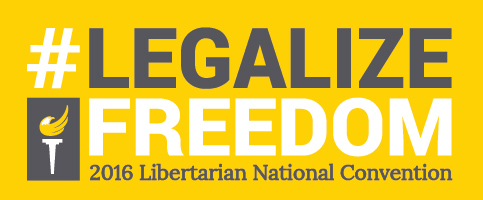
Libertarian Party - Orlando, FL - May 27-30, 2016
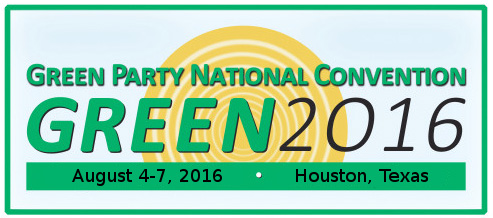
Green Party - Houston, TX - August 4-7, 2016
| REPUBLICAN | DEMOCRATIC | |
| 2016 |
Cleveland, OH
July 18-21 |
Philadelphia,
PA July 25-28 |
| 2012 |
Tampa-St. Petersburg, FL Aug. 27-30 | Charlotte,
NC Sept. 4-6 |
| 2008 | Minneapolis-St. Paul, MN Sept. 1-4 | Denver, CO Aug. 25-28 |
| 2004 | New York, NY Aug. 30-Sept. 2 | Boston, MA July 26-29 |
| 2000 | Philadelphia, PA July 31-Aug. 3 | Los Angeles, CA Aug. 14-17 |
| 1996 | San Diego, CA Aug 12-15 | Chicago, IL Aug. 26-29 |
| 1992 | Houston, TX Aug. 17-20 | New York, NY July 13-16 |
| 1988 | New Orleans, LA Aug. 15-18 | Atlanta, GA July 18-21 |
| 1984 | Dallas, TX | San Francisco, CA |
| 1980 | Detroit, MI | New York, NY |
| 1976 | Kansas City, MO | New York, NY |
| 1972 | Miami Beach, FL | Miami Beach, FL |
| 1968 | Miami Beach, FL | Chicago, IL |
| 1964 | San Francisco, CA | Atlantic City, NJ |
| 1960 | Chicago, IL | Los Angeles, CA |
Note:
H.R.
2019
-
Gabriella
Miller
Kids
First
Research
Act [House passed Dec.
11, 2013, Senate passed March 11, 2014, became law on April 3, 2014]
-"Amends the
Internal Revenue Code to terminate the
entitlement of any
major or minor political party to a payment from the Presidential
Election Campaign Fund for a presidential nominating convention.
Transfers amounts in each account maintained for such purpose for the
national committee of a party to a 10-Year Pediatric Research
Initiative Fund, making them available only for allocation to national
research institutes and national centers through the Common Fund for
making grants for pediatric research under this Act.
Resources
R. Sam Garrett and Shawn Reese. "Funding of
Presidential Nominating Conventions: An Overview." Congressional
Research Service, May 4, 2016.
--. Oct. 2009. NATIONAL
PARTY
CONVENTIONS
1831-2008. Washington, DC: CQ
Press.
"National Party
Conventions 1831-2008
provides focused, detailed, and wide-ranging information on national
party conventions, which have been a key element of the U.S. electoral
process since the early nineteenth century. A comprehension of the
history and evolving structure of the conventions is essential to
understanding how presidential leaders are chosen in the United States.
This
reference presents a thorough examination of U.S. nominating
conventions,
including pre-convention politics, descriptions of the convention
system, and in-depth information on specific conventions and political
parties through the election of Barack Obama in 2008."

